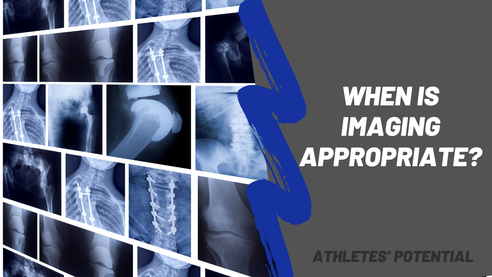When Is Imaging Appropriate?
Mar 18, 2022
In the physical therapy profession, imaging in the form of X-ray and MRI are regular assessments that we request and include within our patient model. Imaging is done, generally, to rule in or rule out certain conditions and to help make a medical diagnosis. Many patients believe that their physical therapist needs to see their X-ray or MRI in order to get appropriate treatment. This is often not the case! Imaging is simply another assessment in which the details therein are considered right alongside other in-clinic details, such as your squat/lunge or night-time pain, that physical therapists use to understand your biomechanics.
Physical therapists are trained to evaluate and treat people without diagnostic test results, full-stop. We do not need radiographs or MRIs to accurately assess and treat your conditions! The medical diagnoses and imaging findings are respected by the therapist, but therapists do not evaluate, prescribe exercises, or otherwise treat based on your imaging. Just as a picture of someone will not tell you a person’s story, a picture of a body part will tell a physical therapist very little about the entirety of the biomechanics of that region!
Additionally, all kinds of “incidental findings” in asymptomatic people can be found in all areas of the body with medical imaging. These findings include disc herniations, spinal stenosis, nerve compression, arthritis, hip and shoulder labrum tears, rotator cuff tendon tears, meniscus tears, signs of inflammation and tendonitis, and others, in asymptomatic people. These types of findings are in all populations – young, old, athletic (recreational to elite level), military, musicians, dominant and non-dominant sides, etc. Below is a summary of a literature review’s findings on spinal MRIs in asymptomatic populations1. As you can see, the prevalence of these findings on MRI does increase with age, but again, these are people without symptoms. Many people are walking around with “abnormal findings” with zero pain.

Pain and injuries are complex and experienced differently by everyone. A physical therapist relies primarily on a physical assessment and detailed history to determine the most appropriate treatment for someone. Each patient, even ones with the same image findings and medical diagnosis, will have a different physical presentation, location, quality, and intensity of symptoms, aggravating movements, physical activity history, stage in the healing process, personality, goals, etc. None of this can be gained from an X-ray or MRI, but all of it is important when treating someone.
So, when is imaging necessary? The most consistent time I send out for imaging is when the expected progression of recovery has stalled or regressed. As a doctor of physical therapy, I am very well trained in expected healing times of tissues. If timing is off for healing and has been so for some time, I request for imaging to add another assessment to the list in order to better fully understand what we are dealing with.
Thanks for reading,
Dr. Marcus PT DPT
Reference:
- Brinjikji, W., et al. Systematic Literature Review of Imaging Features of Spinal Degeneration in Asymptomatic Populations; American Journal of Neuroradiology, April 2015, 36 (4), 811-816; DOI: https://doi.org/10.3174/ajnr.A4173
Let us help you figure out to live your best active life today!
Remember, Movement is Medicine!

